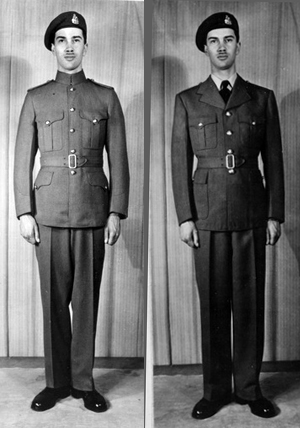The 1946 Proposal for a New No.1 Dress Uniform
By Clive M. Law
Even before the Second World War came to a successful conclusion the British, Canadian and American armies were giving serious thought to the uniform to be worn postwar. Although both Britain and Canada agreed that Battledress, as well as a tropical uniform, would be retained – with minor changes to incorporate improvements suggested during the war – there remained a focus on a No.1 Dress uniform. This focus reflected the belief that Full Dress and Mess Dress were prewar anachronisms. In fact, the wear of both of these orders of dress had been prohibited at the outbreak of war.
A 1946-dated report, prepared by the Canadian Army’s Master-General of the Ordnance (MGO) stated:
“The trend in proposed orders of dress for the United States Army appears to follow closely the British trend. It is intended that there will be one order of dress for all ranks, namely Battledress, which is to be manufactured from worsted olive drab serge. The same material is to be used for all ranks except that officers may make use of superfine tailoring at their own expense. In addition the United States Army proposes a new walking-out or regimental uniform in blue. It is trimmed with a neutral colour (probably a greyish fawn) to simplify provision by the elimination of a great number of regimental or corps colours in the trim. The open collar conventional style with shirt and tie is definitely favoured. A cloth belt is to be worn and peak service cap of the same colour as the uniform. The uniform is to be manufactured of worsted serge or Barathea material of blue.”
“The uniform has not yet been adopted but six or seven departmental models are being displayed to the United States troops in all theatres to obtain their reaction as a guide to design and colour (of blue) and colour of trim (chevrons). The designs being shown have conventional collars, piqued lapels, are semi form fitting with a plain back, full blade, normal waist, and flat hips. They have two breast patched pockets, pleated with three pointed flaps, button and buttonhole throat. The side pockets are cut in, inside hanging with square flaps, button and buttonhole throat.”
Following communications with the British Army, the MGO reported:
“For these purposes a new uniform is proposed, provisionally known as No I dress, normally dark indigo blue in colour, with badges and minor variations of piping etc according to regimental tradition. This uniform is intended for the full-time Army and the scale of issue to be one suit per man. It will not be issued to the Territorial Army. The details are still to be decided but in general it consists of a jacket, and trousers of modified civilian cut with the traditional coloured stripes. A forage cap and coloured girdle (Sam Browne belt for officers) is proposed for formal occasions and a beret and cloth belt, both normally blue, for walking out. Metal buttons, small patrol size and metal badges are retained, but efforts are being made to find a material which does not require cleaning. Black polished boots are prescribed for duty wear and black shoes (with dark blue socks) for walking out.”

The British proposed uniform (worn here by a Canadian model) was a recycling of the prewar blue serge uniform but with the addition of regimental piping to the shoulder straps.
“This uniform is intended for all units except the Scottish Regiments, but for the Rifle Regiments the colour will be rifle green (black in the case of Kings Royal Rifle Corps) instead of dark blue. A separate No I dress, including the kilt and blue bonnet, is contemplated for the Highland Regiments and Highland Light Infantry: Lowland Regts will wear trews in place of the kilt.”
“It will be realized that, owing to the shortage of civilian clothing in this country, it will, in any event, be impossible to introduce a new dress for the army in the near future. It is provisionally estimated that 1st January 1949, is the earliest date when the full requirements of No I dress could be made available.
– Sword – The wearing of the sword is likely to be discontinued
– Highland Units Territorial Army – The matter of Highland Units of the Territorial Army converted to gunners etc is being considered.
– Greatcoat – A project has been initiated to replace the greatcoat for operational use. Several prototypes have been considered. The latest is 3/4 length coat of blue-grey material to be worn with battledress or walking-out dress.”
Insofar as the future No.1 Dress for the Canadian Army was concerned the MGO was considering a number of options. An overview was made available to attendees at the upcoming December 1946, conferences of senior army commanders and of the Defence Association.
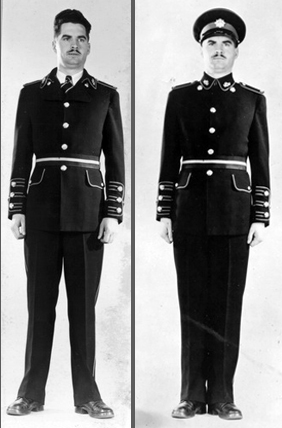
Possibly the most innovative proposals included these two examples. They differ primarily in the collar styling. Cuffs, shoulder straps and trousers would exhibit regimental colours.
The new uniform dress was being considered to replace full dress, undress and possibly mess dress, but its main purpose was to be for ceremonial occasions and walking-out. At the time, No. 1 dress uniform was in the early development stage and several distinctive types had been produced. The types most favoured were of midnight blue colour and manufactured of worsted serge or Barathea cloth. Additional samples had been manufactured in khaki and brown. The various prototypes which have been developed give consideration to the following characteristics:-
HEADDRESS – The peaked service cap was to be of blue colour with a coloured regimental band. A blue beret was also examined. It was proposed the various headdresses as worn by Highland, Scottish and Irish Regiments would continue to be worn when applicable.
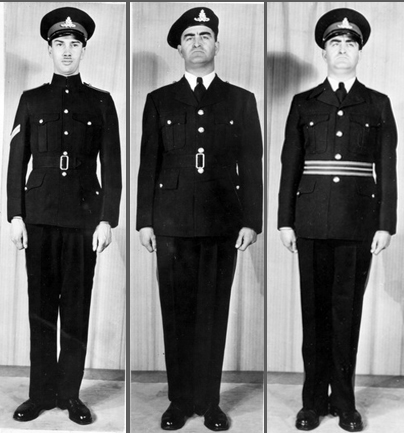
Three more propsaed uniforms. Many of these were simply variants on three basic themes – colour, collar and headdress.
JACKET –
(a) Collar – The decision as to whether an open collar or stand-up (patrol) collar would be adopted was undecided and a number of prototypes were produced. It was proposed that unit collar badges would be worn in either case. The use of coloured regimental piping on the collar edges was also considered.
(b) Shoulders straps – The prototypes continued the use shoulder straps and both ‘sewn-in’ and removable were considered with and without coloured regimental piping. It was proposed that unit shoulder titles could be worn in either case.
(c) Sleeves – The concept uniforms included the use of regimental buttons and coloured regimental piping on the cuffs with both plain and pointed cuffs proposed.
(d) Buttons – Metal regimental buttons were proposed on the various prototypes.
(e) Breast-pockets – Prototypes included the use of breast-pockets.
(f) Side Pockets – The use of side pockets with and without coloured regimental piping.
(g) Girdle and Belt – The use of a regimental girdle (commonly referred to as Stable belts) for wear on ceremonials and the cloth belt to match the jacket for wear when walking out was advanced.
(h) Pattern – For Highland and Scottish units it was intended that the jacket be modified for wear with kilts or trews.
TROUSERS – The use of coloured regimental stripes or piping in the trousers.
SHOES – It was proposed that either shoes or boots may be worn depending upon the occasion.
SAM BROWNE BELT – In the case of officers the Sam Browne belt could be worn with the jacket.
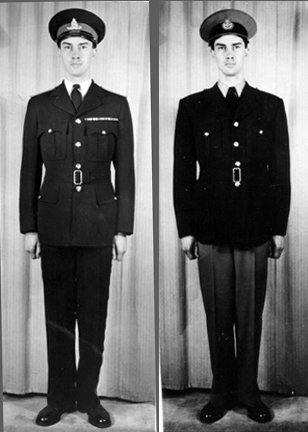
These two proposals more closely emulated civilian dress. A beret was optionally considered. In any event the final decision would see the elimination of firage caps for Other Ranks and it would be 10 years before these were returned.
In any event, the final choice was more traditional with the simple blue serge selected but with the use of a coloured beret in lieu of the pre-war coloured forage cap. Although a “No.1” uniform is referenced in the 1947 Dress Regualtions there is no description of it. In fact, this order of dress would not be formalised until publication of the 1953 Orders and Instructions for Dress of the Canadian Army. Ironically, where No.1 was intended to replace Full Dress and Mess Dress, both of these orders of Dress made their way back into the Canadian Army – either with official sanction such as for the Brigade of Canadian Guards’ Public Duties responsibilities, or privately funded by Regimental Associations.
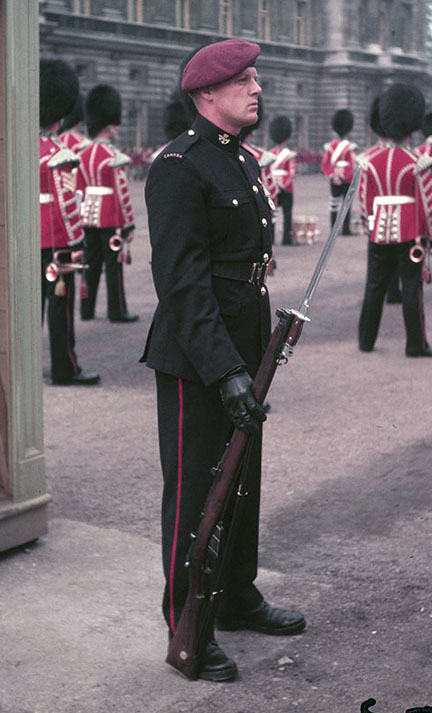
The new No.1 Dress uniform worn at the 1953 Coronation of HM Queen Elizabeth II. Photo courtesy Bruce Graham
Did you enjoy this article? Please ‘rate’ it by clicking on the stars below

